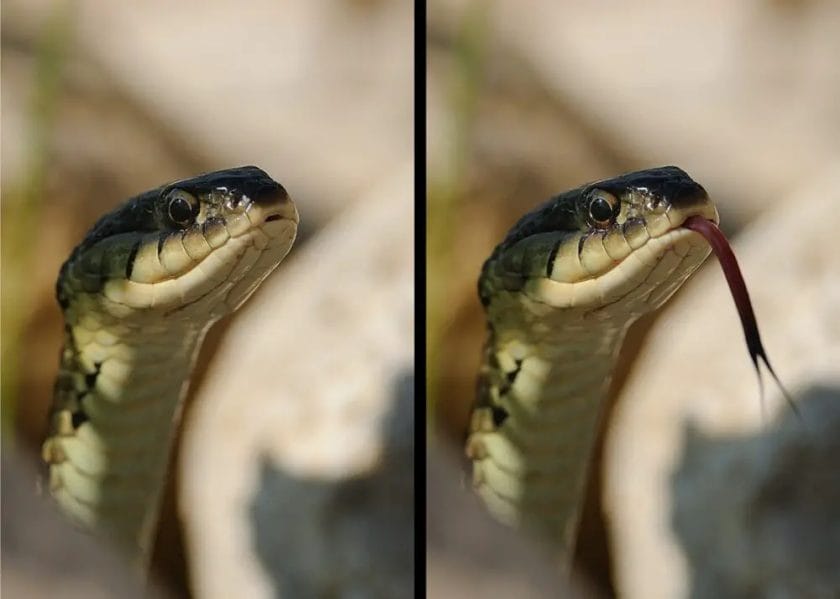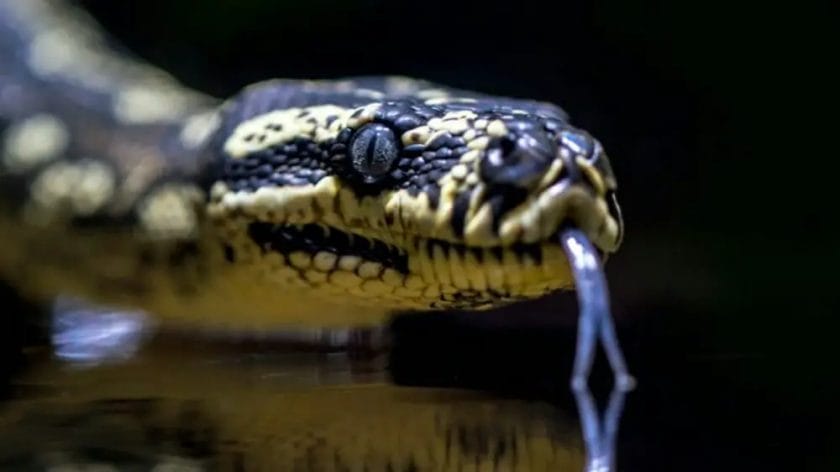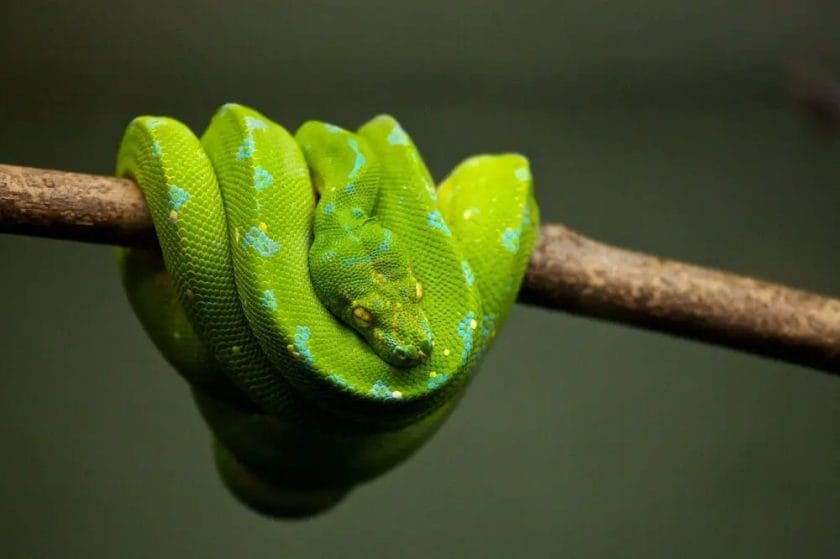If you’re wondering what sound a snake makes, you might be surprised to learn that most snakes are actually silent creatures. They don’t have vocal cords like mammals, so they don’t produce traditional sounds like barks or meows. Instead, snakes communicate through hissing, which is a loud, high-pitched sound made by forcing air through their trachea. This hissing sound is typically a warning signal, meant to intimidate predators or intruders.
However, it’s essential to note that not all snakes hiss. Some species, like the rattlesnake, have developed unique adaptations to create a distinct rattling sound using their tails. This sound serves as a warning to potential threats, signaling their presence and giving a chance for others to keep their distance.
While snakes may not make the same kinds of sounds as other animals, their unique methods of communication ensure they can protect themselves and navigate their environments effectively.

Understanding Snake Vocalizations
Snakes are fascinating creatures that have captivated human curiosity for centuries. While they may not be known for their vocal abilities like birds or mammals, snakes do have a unique way of communicating through vocalizations. In this section, we will explore the different types of snake vocalizations and what they mean.
Hissing
One of the most iconic snake vocalizations is the hiss. When a snake feels threatened or agitated, it will often emit a hissing sound. This is caused by the snake forcefully expelling air through its glottis, a specialized structure located at the back of its throat. The hiss serves as a warning to potential predators or threats, signaling that the snake is prepared to defend itself if necessary.
It is important to note that not all snakes hiss. Some species, like the ball python, are known for being generally docile and rarely exhibiting aggressive behavior. However, when threatened, even the most mild-mannered snake may resort to hissing as a form of self-defense.
Rattling
The rattlesnake is perhaps the most well-known example of a snake with a unique vocalization – the rattle. Located at the tip of the snake’s tail, the rattle is composed of a series of interlocking segments of keratin. When the snake feels threatened, it rapidly vibrates its tail, causing the segments to rattle against each other. This creates a distinctive sound that serves as a warning to potential predators or intruders.
The rattlesnake’s rattle is a highly evolved adaptation that allows the snake to alert others to its presence without expending unnecessary energy. The sound of a rattlesnake’s rattle is often enough to deter predators and prevent a potentially dangerous encounter.
Purring
While less commonly heard, some species of snakes are capable of vocalizing a purring sound. This unique vocalization is produced by the constriction of muscles in the snake’s throat and is often associated with courtship or mating behavior. Male snakes may emit a purring sound to attract a female, indicating their interest and readiness to mate.
It is important to note that snake vocalizations can vary greatly depending on the species and context. Some snakes may produce sounds that are difficult for humans to hear, while others may not vocalize at all. Additionally, snakes primarily rely on visual cues, scent, and body language to communicate, with vocalizations being just one piece of the puzzle.
In summary, while snakes may not have the same vocal capabilities as other animals, they have developed unique ways of communicating through vocalizations. From hissing to rattling to purring, these sounds serve as a means of warning, defense, and courtship. Understanding snake vocalizations can provide valuable insights into the behavior and communication methods of these remarkable creatures.

The Hissing Sound of Snakes
Snakes are fascinating creatures that have captured the attention and curiosity of humans for centuries. One of the most distinctive and iconic characteristics of snakes is their ability to produce a hissing sound. In this section, we will explore the fascinating world of snake hissing and unravel the mysteries behind this unique behavior.
1. The Purpose of Hissing
Hissing is a vocalization method used by snakes to communicate with their surroundings. While snakes lack vocal cords, they have developed alternate mechanisms to produce sounds. Hissing is primarily a defensive behavior used to warn potential threats or predators to stay away.
When a snake feels threatened, it will inflate its body and expel air rapidly through small openings called spiracles on the sides of its throat. This forceful expulsion of air creates the characteristic hissing sound that serves as a warning signal.
2. Hissing Variations
Not all snakes produce the same type of hissing sound. Different species of snakes have distinct variations in their hissing patterns. Some snakes produce short, sharp hisses, while others emit long, sustained hisses.
The intensity of the hissing sound can also vary depending on the snake’s size and the level of perceived threat. Larger snakes typically produce louder and more menacing hisses, while smaller snakes may emit softer hissing sounds.
3. Defensive Hissing
Hissing plays a crucial role in the snake’s defense mechanism. When confronted by a potential threat, a snake will first try to intimidate the intruder by hissing loudly. The hissing sound is meant to startle and warn the intruder, signaling that the snake is ready to defend itself if necessary.
Some snakes may also use hissing as a form of bluffing. By exaggerating their size and aggression through intense hissing, they hope to deter predators without having to engage in physical confrontation.
4. Communication Through Hissing
While hissing is primarily a defensive behavior, snakes also use it as a means of communication with other snakes. Male snakes, for example, may hiss to assert dominance or to attract a female during mating season.
Snakes also use hissing to communicate during territorial disputes. By hissing at intruding snakes, they establish their presence and assert their claim over a particular area.
5. Mimicking Hissing Sounds
Interestingly, some non-venomous snakes have evolved the ability to mimic the hissing sounds of venomous snakes. This mimicry serves as a form of protective camouflage, deterring potential predators from approaching.
By imitating the hissing sound of venomous snakes, these non-venomous snakes gain a psychological advantage, making predators believe that they pose a greater threat than they actually do.
Summary
The hissing sound of snakes is a unique and fascinating aspect of their behavior. It serves as a warning signal, a means of communication, and a defensive mechanism all in one. The variations in hissing patterns among different snake species add to the intrigue and diversity of their vocalizations. So, the next time you hear a snake hiss, remember that it is their way of saying “Stay away!”

Rattlesnakes and their Distinctive Rattle
Rattlesnakes are a type of venomous snake that are found in various parts of North and South America. One of the most distinguishing features of rattlesnakes is their unique rattle, located at the end of their tail. This rattle is made up of a series of interlocking segments, which produce a rattling sound when the snake vibrates its tail.
The primary function of the rattle is to serve as a warning device. When a rattlesnake feels threatened or believes that it is in danger, it will shake its tail rapidly, causing the segments of the rattle to collide and produce the distinctive rattling sound. This serves as a signal to potential predators or intruders to stay away.
The rattle of a rattlesnake is a highly evolved adaptation that has been honed over millions of years. It is an effective means of communication, allowing the snake to warn others of its presence without having to engage in a potentially dangerous confrontation. The sound of the rattle can often be heard from a significant distance, providing ample warning to both humans and animals in the vicinity.
Interestingly, the number of segments in a rattlesnake’s rattle can provide some insight into the age of the snake. Each time a rattlesnake sheds its skin, it adds a new segment to its rattle. By counting the number of segments, one can estimate the number of times the snake has molted, which can provide an approximate age range for the snake.
The rattle itself is composed of keratin, the same material that makes up human hair and nails. Each segment is hollow and tapers towards the end, creating a unique structure that allows for the production of sound. The size and shape of the rattle can vary among different species of rattlesnakes, with some having longer and more slender rattles, while others have shorter and wider ones.
It is important to note that not all rattlesnakes have a fully formed rattle. Young rattlesnakes are born with a small button-like structure called a pre-button, which is not capable of producing sound. As the snake grows and sheds its skin for the first time, it adds its first segment to the rattle, thus developing the characteristic rattle that is associated with rattlesnakes.
In summary, rattlesnakes are venomous snakes that possess a unique adaptation in the form of a rattle at the end of their tail. This rattle serves as a warning device, producing a distinctive rattling sound when the snake feels threatened. The number of segments in the rattle can provide an estimate of the snake’s age, and the size and shape of the rattle can vary among different species. The rattle is composed of hollow, tapered segments made of keratin, and is a highly effective means of communication for rattlesnakes.
Unusual Snake Noises: Growls, Huffs, and more
Snakes have long been associated with hissing as their primary form of communication. However, did you know that snakes can also produce a variety of other sounds? These unusual snake noises, such as growls, huffs, and rattles, serve different purposes and provide fascinating insights into the world of these slithering creatures.
Hissing: The Classic Snake Sound
Before delving into the lesser-known snake noises, it’s important to acknowledge the most familiar sound associated with snakes – hissing. When threatened or agitated, many snake species produce a hissing sound by forcefully expelling air through their mouth. This hiss is created by the rapid movement of the snake’s glottis, a part of its respiratory system. The hissing sound is intended to intimidate predators and warn potential threats to back off.
Rattling: A Warning Signal
One of the most iconic snake sounds is the rattling noise made by certain species, such as rattlesnakes. This distinct sound is created by specialized tail segments called “rattles.” When a rattlesnake feels threatened, it vibrates its tail rapidly, causing the segments to rattle against one another, producing a warning sound. The purpose of this noise is to alert potential threats to the snake’s presence and deter them from approaching.
Growling: A Surprising Sound
While growling is often associated with mammals, some snake species are capable of producing a similar noise. For example, the Amazon tree boa (Corallus hortulanus) is known for its low growl-like vocalization. The sound is generated by the movement of air through the snake’s respiratory system, similar to hissing. It is believed that growling in snakes serves as a form of communication during courtship or territorial disputes.
Huffing: Expressing Discomfort
Another unusual snake noise is huffing, which can be described as short, forceful exhalations of breath. Snakes may huff to communicate their discomfort or displeasure. The Eastern Hognose Snake (Heterodon platirhinos) is particularly known for its dramatic huffing behavior when feeling threatened. This sound, accompanied by defensive posturing such as flattening its neck or feigning death, aims to intimidate predators and deter them from further aggression.
Rasping: Defensive Warning
Several snake species have the ability to produce a rasping noise, which is created by the rapid movement of their scales against rough surfaces. This sound is typically heard when a snake feels threatened and is attempting to warn potential predators or intruders. The sound can be likened to the scraping of a rough surface and serves as a defensive mechanism to ward off potential threats.
Croaking: A Unique Serpentine Sound
While not a sound frequently associated with snakes, some species, like the gray’s smooth snake (Coronella austriaca), produce croaking sounds. Though not as well-studied as other snake noises, croaking is believed to be a form of communication, possibly used during courtship rituals or to establish territory boundaries.
Summary
In summary, snakes are not limited to hissing when it comes to vocalization. They have a diverse range of noises at their disposal, including growls, huffs, rattles, rasps, and even croaks. These unusual snake sounds serve various purposes, such as warning predators, communicating during courtship, expressing discomfort, or establishing territorial boundaries. Understanding these unique vocalizations adds to our knowledge and appreciation of these fascinating reptiles.
FAQs
What sound does a snake make?
Snakes do not make typical vocal sounds like other animals. Instead, they make a variety of hissing, rattling, or vibrating noises using their bodies. Some snakes, like the rattlesnake, produce a rattling sound by shaking their tail, while others may hiss or emit a low-frequency vibration known as a “booming” sound.
Conclusion:
In conclusion, while snakes are fascinating creatures with unique characteristics, they are not known for making typical animal sounds like birds or mammals. Instead, snakes produce a variety of hissing, rattling, and buzzing noises using specialized body parts.
These sounds serve a range of purposes, including defense, communication, and attracting mates. Some snakes, such as rattlesnakes, use their tail rattles to warn potential threats, while others may hiss to express aggression or fear. However, it’s important to note that not all snake species make audible sounds, and their communication methods can vary.
Understanding snake sounds and behavior can be crucial for snake enthusiasts, researchers, and those working in snake-occupied environments. By studying these unique vocalizations, we can gain valuable insights into their complex world and foster a greater appreciation for these intriguing reptiles.
